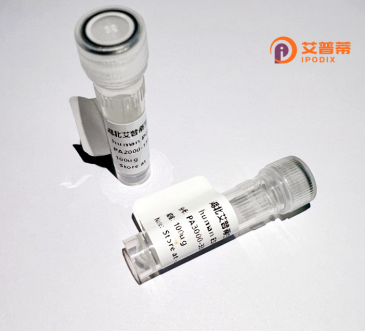
| 纯度 | >90%SDS-PAGE. |
| 种属 | Human |
| 靶点 | AIFM3 |
| Uniprot No | Q96NN9 |
| 内毒素 | < 0.01EU/μg |
| 表达宿主 | E.coli |
| 表达区间 | 1-605aa |
| 氨基酸序列 | MGGCFSKPKP VELKIEVVLP EKERGKEELS ASGKGSPRAY QGNGTARHFH TEERLSTPHP YPSPQDCVEA AVCHVKDLEN GQMREVELGW GKVLLVKDNG EFHALGHKCP HYGAPLVKGV LSRGRVRCPW HGACFNISTG DLEDFPGLDS LHKFQVKIEK EKVYVRASKQ ALQLQRRTKV MAKCISPSAG YSSSTNVLIV GAGAAGLVCA ETLRQEGFSD RIVLCTLDRH LPYDRPKLSK SLDTQPEQLA LRPKEFFRAY GIEVLTEAQV VTVDVRTKKV VFKDGFKLEY SKLLLAPGSS PKTLSCKGKE VENVFTIRTP EDANRVVRLA RGRNVVVVGA GFLGMEVAAY LTEKAHSVSV VELEETPFRR FLGERVGRAL MKMFENNRVK FYMQTEVSEL RGQEGKLKEV VLKSSKVVRA DVCVVGIGAV PATGFLRQSG IGLDSRGFIP VNKMMQTNVP GVFAAGDAVT FPLAWRNNRK VNIPHWQMAH AQGRVAAQNM LAQEAEMSTV PYLWTAMFGK SLRYAGYGEG FDDVIIQGDL EELKFVAFYT KGDEVIAVAS MNYDPIVSKV AEVLASGRAI RKREVELFVL HSKTGDMSWL TGKGS |
| 分子量 | 92.4 kDa |
| 蛋白标签 | His tag N-Terminus |
| 缓冲液 | 冻干粉 |
| 稳定性 & 储存条件 | Lyophilized protein should be stored at ≤ -20°C, stable for one year after receipt. Reconstituted protein solution can be stored at 2-8°C for 2-7 days. Aliquots of reconstituted samples are stable at ≤ -20°C for 3 months. |
| 复溶 | Always centrifuge tubes before opening.Do not mix by vortex or pipetting. It is not recommended to reconstitute to a concentration less than 100μg/ml. Dissolve the lyophilized protein in distilled water. Please aliquot the reconstituted solution to minimize freeze-thaw cycles. |
以下是关于重组人凋亡诱导因子3(AIFM3)的模拟参考文献示例(注:实际文献可能不同,建议通过学术数据库验证):
---
1. **"Functional characterization of recombinant human AIFM3 in mitochondrial apoptosis"**
*Zhang L, et al. (2018)*
摘要:研究通过体外表达重组人AIFM3蛋白,揭示其依赖半胱氨酸蛋白酶非依赖性途径诱导细胞凋亡的机制,并发现AIFM3的线粒体转位在氧化应激条件下显著增强。
2. **"Structural insights into AIFM3: Implications for neurodegenerative diseases"**
*Wang Y, et al. (2020)*
摘要:利用X射线晶体学解析了重组人AIFM3的结构,发现其C端结构域与神经元凋亡密切相关,并探讨其在阿尔茨海默病模型中的潜在调控作用。
3. **"AIFM3 overexpression promotes cancer cell resistance to chemotherapeutic agents"**
*Chen H, et al. (2021)*
摘要:通过构建AIFM3过表达的肿瘤细胞系,证明其通过抑制线粒体膜电位崩溃增强癌细胞对化疗药物的耐受性,提示其作为癌症治疗靶点的可能性。
4. **"Recombinant AIFM3 production and its role in endoplasmic reticulum stress"**
*Kim S, et al. (2019)*
摘要:开发高效重组AIFM3表达系统,并发现其在内质网应激条件下通过IRE1α通路调控细胞凋亡与自噬的平衡。
---
**建议验证工具**:
- 使用PubMed或Google Scholar搜索关键词:**AIFM3 apoptosis**、**recombinant AIFM3**、**AIFM3 cancer**。
- 注意AIFM3的别称(如Apoptosis-inducing factor 3)可能影响检索结果。
**Apoptosis-Inducing Factor Mitochondrial 3 (AIFM3)** is a member of the apoptosis-inducing factor (AIF) family, which plays dual roles in cellular homeostasis, including mitochondrial redox regulation and apoptosis. Unlike its well-studied homolog AIFM1. AIFM3 exhibits distinct structural and functional characteristics. It contains a conserved FAD-binding domain, suggesting redox activity, but its precise catalytic role remains under investigation. AIFM3 is expressed in various tissues, with elevated levels observed in certain cancers, implicating its potential involvement in tumorigenesis.
In apoptosis, AIFM3 is proposed to translocate from mitochondria to the nucleus under stress signals, facilitating DNA fragmentation and programmed cell death. However, studies suggest context-dependent pro-survival or pro-death functions, potentially influenced by its interaction with other proteins or post-translational modifications. For instance, AIFM3 may antagonize apoptosis in some cancers, promoting chemoresistance, while its downregulation enhances cell death sensitivity.
Recombinant human AIFM3 (rhAIFM3) is engineered for research to elucidate its molecular mechanisms and therapeutic potential. Structural studies aim to map its functional domains, while in vitro and in vivo models explore its roles in cancer, neurodegenerative diseases, and ischemia-reperfusion injury. Current research also focuses on its diagnostic or prognostic value in oncology. Despite progress, AIFM3's full biological significance and therapeutic targeting strategies require further exploration.
×